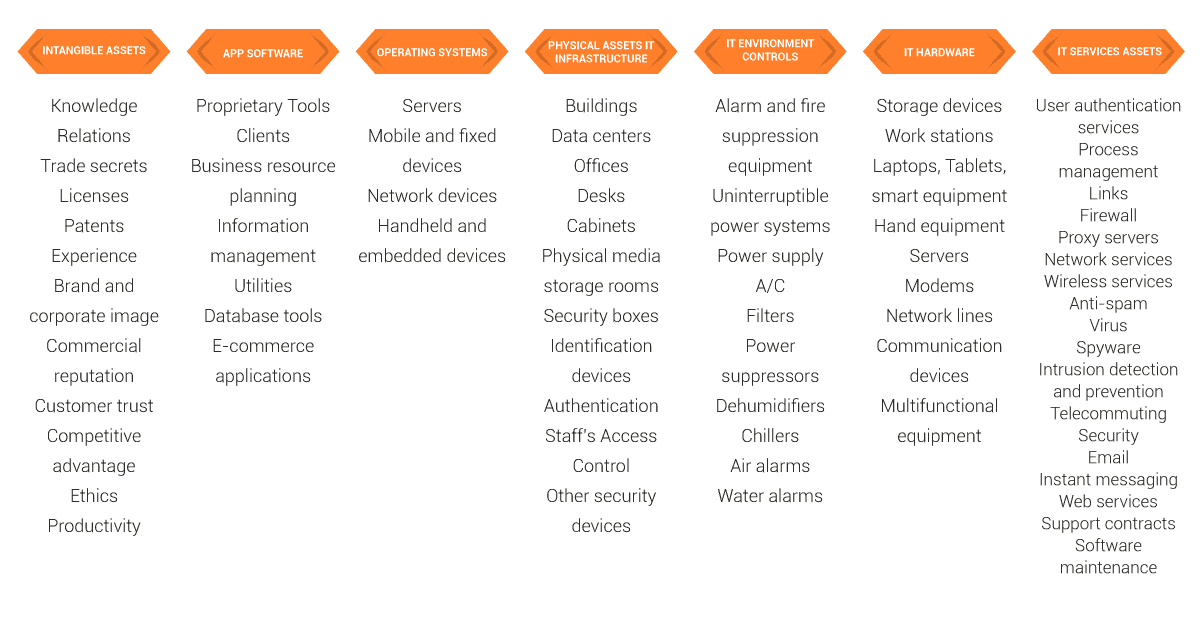What is an IT asset?
First of all, an IT asset composes the technological resources that every company has to streamline its management. They are employed to achieve business goals, and they divide into tangible and intangible assets (hardware, software and knowledge):

They’re a lot, right? Now imagine how would it be to track down all of them. This is the same panorama that every company had to dealt with before IT Asset Management arrived. Now, according to Wikipedia:
IT asset management (ITAM) is the set of business practices that join financial, contractual and inventory functions to support life cycle management and strategic decision making for the IT environment. Assets include all elements of software and hardware that are found in the business environment.
So, IT Asset Management tools help companies to monitor and fully know the real state of each technological resource they actually count on. Especially because every company need to fill specific requirements to meet current market demands.
Then, an example of the usefulness of IT Asset Management tools are IT inventory management models. It’s very simple: Just as every company needs a proper warehouse to store their physical assets to guarantee the proper distribution of products and services for internal and external customers; they also need to know and control their IT Assets.
Of course, the bigger our company is, the greater volume of IT assets we need to track and control. Especially if we use technology to globally expand our operations by means of teleworking.
Now, how do I track and control all that information?
 Simple: Taking an inventory of your IT assets.
Simple: Taking an inventory of your IT assets.
The main objective of any warehouse is employing a predetermined space to protect; access to and quickly and safely dispose of products, goods or services.
To achieve this; it’s necessary to review and consider an effective way to distribute and store them in such space. And this is how we come across with the basic concepts of storage and inventory. All of them extend to and find their equal in the virtual space; and this is where IT asset management helps you to visualize and locate your resources.
IT Asset Management, Storage and Inventory
Following, inventories are resources (goods, services, finished goods, parts, consumables, furniture, software, licenses, etc.) stored to dispose of them in the present or future. They represent a large part of the investment of any company and therefore, it’s essential to update all the information related to their use; status and mobility.
In addition, inventories help to discriminate processes (Production vs. Distribution); to classify types of merchandise; products and/or services; and allow the correct flow of operations and transactions. The information obtained from these processes and stages allow to determine the right time to replace and dispose the stock.
Also, there are two basic storage models:
Chaotic Model
 In first place, we find the chaotic model for organizing the assets. In this model, the space occupation bases on availability. Lack of organization or logical order is the main premise. However, such lack of logical order brings advantages such as optimization of space and quick access to the product or service demanded.
In first place, we find the chaotic model for organizing the assets. In this model, the space occupation bases on availability. Lack of organization or logical order is the main premise. However, such lack of logical order brings advantages such as optimization of space and quick access to the product or service demanded.
A virtual example of chaotic storage occurs right in our own PCs: Our favorite places to store the latest files we work on are whether the Desktop or the Downloads folder; even when the logical order is giving them a more permanent and organized destination within the many folders we already have, or can create.
This example extends to IT asset in enterprises; especially at the beginning of operations.
Organized Model
 Second, we find this model which is diametrically opposed to the above described. The creation and previous allocation of space by affinity or reference for the distribution and logic storage of assets.
Second, we find this model which is diametrically opposed to the above described. The creation and previous allocation of space by affinity or reference for the distribution and logic storage of assets.
Notably, this model makes easier the management of any type of warehouse and inventory; and allows immediate visibility of the assets in demand. Also, it guarantees a correct flow of products or materials; helps to reduce costs and optimizes internal and external customer service.
However, the more time companies lose before adopting any kind of control over their IT assets; the more complicated becomes adopting the organized model for inventory control. However, both models can be administered with control IT asset management tools.
Control tools for IT Asset Management and Inventory
 Summarizing, automated tools for IT asset management establish standards and define the processes related to the purchase; documentation; distribution; use and change of software and related assets. This includes physical assets; licenses; support management and security compliance.
Summarizing, automated tools for IT asset management establish standards and define the processes related to the purchase; documentation; distribution; use and change of software and related assets. This includes physical assets; licenses; support management and security compliance.
Also, automated tools for IT asset management control production costs. On the other hand; they also indicate the use and status of remote devices associated with your infrastructure to take close control of the product’s Life Cycle.
IT assets management automated tools base their schemes and actions on international standards (ISO – ITIL – COBIT) to cover the activities of Planning; Implementation, testing and documentation; and Deployment and maintenance.
With this simple but effective scheme of work; IT asset management tools maximize all the tasks involved in the process of controlling the inventory of your IT assets to gain visibility of your resources, no matter where they are. In general, this model improves workflow; prevents interruptions; increases service quality and makes smoother transition or changes.



